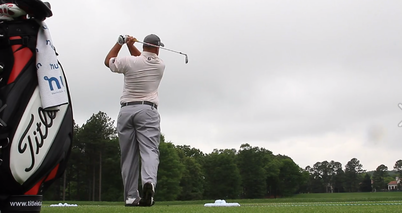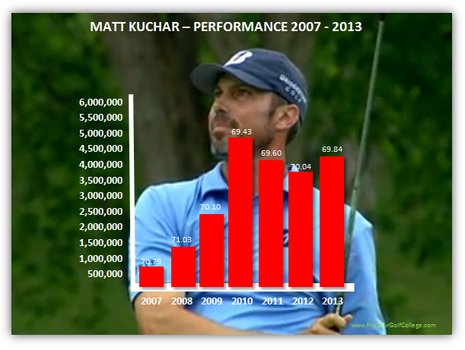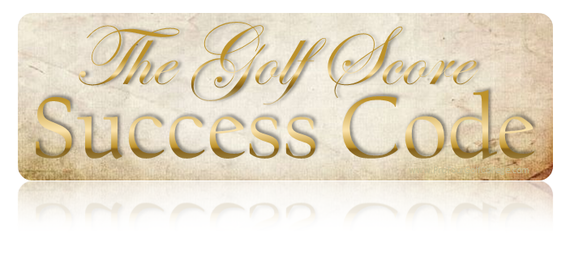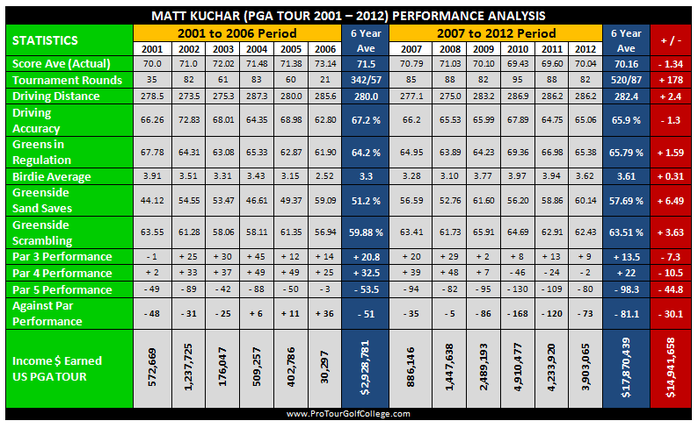"Remember this because it's very important. Score comes first, strategy comes second, and effort comes third. If you want to become a much better golfer than you currently are, then you need to define exactly what that means to you, rather than wandering through the golf wilderness waiting for your success to come to you. Believe me, you will be waiting a long time and you will be disappointed".  Can you imagine just for a moment what it would be like to practice golf every day without a clearly defined goal? Imagine putting continuous effort into your golf without a clear idea of why you’re doing it. Your best answer to someone who asks you why you’re practicing so much is that you want to play on the pro tour one day. Believe it or not there are lots of golfers doing precisely this, and setting themselves up for failure! Anything worthwhile requires a big goal and a way of getting to it. It doesn't have to be complicated, just a simple map that gets you from A to B with a minimum of fuss. For instance the golfer that is practicing to play on a pro tour has a worthy goal. The key is how to get there, and once you’re there, to stay there. As you would know by now if you read our blog posts, we study the successful golfers and those that are trying to be to try and identify what the difference is that makes the difference in professional golf. Now as you can imagine this opens up a can of worms with the different golf improvement camps jockeying for position to promote their way as the best way to achieve success in golf. You have the golf instructors, the psychologists and the sports scientists who want you to adopt their way, and the media to add their bit to the puzzle. That is why when all is said and done, success in golf gets down to a simple fundamental of golf - the score. Golf has always involved a score, and yet the crazy thing about golf today is that many young aspiring golfers are told not to focus on the score as it distracts you. Soccer or football wouldn’t be much of a game if no one scored a goal. The goal of golf is to produce a golf score on each hole, and a score after 18 holes that ultimately leads you to the success you are striving for. Why is this so hard to understand? I think the reason is that there is so much noise from all the camps vying for your business. And there’s certainly nothing wrong with this, if you can get to your goal right?  You have to decide if your destiny is to perfect your golf swing technique or your golf score. It is that simple. And one doesn’t necessarily lead to the other, so you better make sure that you choose wisely, because once you start on the path, it's difficult to find your way back to the start. Golf is a game of score first. To my way of thinking the reason a team goes out onto a field to play football is to score more goals than the other team, and so the key to achieving this is two things; a goal and a strategy to achieve it, like I said earlier. Jack Nicklaus said to Lee Trevino before the 1971 US Open at Merion that he thought a score of 280 would win it. As it turned out Lee Trevino and Jack Nicklaus played off for the title after both scoring 280 over four rounds at Merion, with Lee Trevino winning in the play off. The goal was 280, and the strategy was how they went about achieving it. That is the basic facts behind playing golf competitively. Score = Strategy x Effort Remember this because it's very important. Score comes first - your goal, and strategy comes second. If you want to become a much better golfer than you currently are, then you need to define exactly what that means to you, rather than wandering through the golf wilderness waiting for your success to come to you. Believe me, you will be waiting a long time and you will be disappointed. On numerous occasions I have heard Tiger Woods talk about his goal score for the week when interviewed prior to a tournament. And even during the tournament he will talk about where his score is compared to his goal score for the week. Remember; Score = Strategy x Effort Now let’s talk about the score that will give you all the success you desire in golf. We call it The Golf Score Success Code and this number just keeps popping up as we carefully analyse successful golfers from those that are not. Remember we define success in professional golf as making a lot more money than you spend, which is easier to do when you reach or get close to the golf success code standard. When we talk about score we define it as your actual score average against par. Not an adjusted average, but your golf score against par. So when you play competitively over a year on par 70, 71 and 72 layouts, (or others) you take your average score for the year and compare it to the average par. This is your true golfing standard – no handicaps or adjustments, just a competitive score average against par. This is the mind-set we want you to adopt if you have desires of becoming a successful amateur or professional golfer. Score = Strategy x Effort  Matt Kuchar has developed into one of the best golfers in the world and I sat down and had a good look at his performances since he left the Nationwide Tour (now the Web.Com tour) to identify some of the key performance indicators that might be influencing his improved play. The first thing to understand is I looked at his results over the period of 1998 to 2013 - 15 years which straight away should tell you that he has been hard at it for a relatively long period of time. This is consistent with the studies on developing world class expertise in your field or domain as most of the research points to periods over 10 years to achieve this exalted level of performance. I split the period of Matt Kuchar's PGA Tour performances from 2001 to 2006 and the period after 2006, from 2007 to 2012. The reason I did this was to show you how much improvement he has made after 2006 when he started working with Jim Hardy of The One Plane Swing fame, and now with Chris O'Connell who teaches Jim Hardy's philosophy. It is interesting when you look closely at the numbers, which I have summarized in the table below for you. I urge you to carefully look at the numbers before 2007, and those after, because you will learn a lot about why Matt Kuchar is playing so well, and this will undoubtedly help you and your game. Tee to Green Skills The first thing to notice is that his tee to green performances from the first period to the second period don't show a lot of difference which I think many golf swing coaches would find interesting. It you look at the numbers in the table below, he hits it 2.4 yards longer on average in the 2nd period to the first (280.0 yards to 282.4 yards) and misses 1.3 percent more fairways. His greens in regulation in the 2nd period has improved slightly, by 1.59 percent, from 64.2 percent to 65.79 percent, again not a big difference. So at face value it doesn't look like a lot of difference does it? Greenside Skills and Birdies So I looked at his green-side skills and his birdie average to see if there was a noticeable difference that would explain his success, and again I was surprised to see just a little bit of improvement in his green-side skills, but nothing like I expected.
Matt's birdie average improved from 3.3 birdies per round for the first period to 3.61 birdies per round for the next period. This was an improvement of 0.31 which definitely translates into a lower golf score average. Score Against Par So I went further into the numbers (there are lots) and started to notice a lot of improvement in the his scoring ability from the first period to the second period. There is a definite shift in Matt Kuchar's performances when you look at them over 12 years (Big Picture View) and even though he has played a lot more tournaments in the 2nd period to the first, the one standout statistic is his competitive score average. 71.5 to 70.16 Matt Kuchar improved his competitive score average by 1.34 strokes in the 2nd period from 71.5 to 70.16. So the work that he has done with his coach Chris O'Connell (Score = Strategy x Effort) has translated into a lower competitive score average, which is the bottom line in professional golf, and also the bottom line responsibility of your golf coach/instructor. Now here's where it gets interesting; notice the improvement in his par 3, 4, and 5 averages from the first period to the second, and you'll understand why it is so important to start with the numbers as your goal, and then build your strategy for improvement from there.
 So Matt Kuchar is playing more competitive rounds in the 2nd period but has found a way to improve his scoring average by 1.34 strokes playing more rounds of golf. Now look at his 'against par performances' and his average for the first period is 51 under par for an average of 57 competitive rounds played on the PGA Tour. Pretty impressive until you look at his improvement in the 2nd period where he improved by 30.1 strokes against an average of 87 competitive rounds per season. In-fact if you look closely at the numbers you see that he has done exactly what you have to do to become a successful professional golfer; he has played the par 5's a lot better and amazingly he improved by 44.8 strokes for the 2nd period as compared with the first. So even though we don't see much improvement in his tee to green game, we see that he has improved his scoring ability, which is the most important factor. His long game and green-side skills are similar to the first period, but his scoring ability has gone to another level. We find this continually as we study the top golfers; they find ways to lower their score average even when they are already very fine golfers. The lesson we learn from this is not only do they have the goal of improving their score average, they find the best strategies for achieving this goal, and then go to work on them. Remember; Score = Strategy x Effort Have a look at the image above showing Matt Kuchar's earnings for the 2nd period including 2013 after his win at the Memorial Tournament. He has earned nearly 20 million dollars in prize money since 2007 and the one common denominator is that his actual score average (against par average) is right around 70.00 across the 7 years. Now compare that to the 2001 to 2006 period. He is playing at this level because he has learned and applies the golf score success code: Score = Strategy x Effort 12 Pars - 4 Birdies - 2 Bogeys Our studies of top class golfers keeps highlighting this 12 - 4 - 2 standard for success in golf at amateur or professional level. You will find that by beginning with the end in mind (your score goal) and then developing the most effective strategy with the help of your golf coach, and then putting the work in that's required, that you too can achieve your goal of improving your competitive score average, and obtaining the success that you desire from this great game. Lawrie Montague and David Milne - Pro Tour Golf College Your Success On Tour is Our Business Comments are closed.
|
Archives
June 2019
|
Proudly Supported By
Copyright © 2011 - 2018 Pro Tour Golf College
Website Managed By Golf Performance Media
All Rights Reserved
Website Managed By Golf Performance Media
All Rights Reserved







 RSS Feed
RSS Feed



